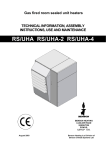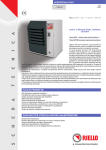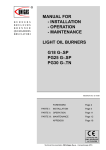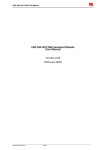Download BENSON RS Technical information
Transcript
Gas room sealed unit heaters 2 stage TECHNICAL INFORMATION ASSEMBLY INSTRUCTIONS, USE AND MAINTENANCE RS/UHA-2 BENSON HEATING LUDLOW ROAD KNIGHTON POWYS LD7 1LP MAY 2003 Benson Heating is a divison of Benson Climate Systems Ltd COMPLIANCE NOTICES The Benson RS/UHA2 range of warm air heaters detailed herewith are manufactured for Benson Heating within the parameters of ISO 9002. The Benson RS/UHA2 Range has been independently tested and assessed, and has been found to meet the Essential Requirement of the following European Directives: Gas appliance Directive (90/396/EEC) Machinery Directive (89/392/EEC) 91368/EEC 93/44/EEC 93/65/EEC Low Voltage Directive (73/23/EEC Electromagnetic Compatibility Directive (98/336/EEC and 91/31/EEC) Product Liability Directive (65/374/EEC) The manufacturer has taken reasonable and practical steps to ensure that Benson RS/UHA2 Range of Heaters are safe and without risk when properly used. These heaters should therefore only be used in the manner and purpose for which they were intended, and in accordance with the recommendations detailed herewith. The heaters have been designed, manufactured, assembled, inspected, and tested, with safety and quality in mind, there are certain basic precautions which the installer and user should be aware of, and they are strongly advised to read the appropriate sections of the information pack accompanying the heater, prior to installation or use. Benson Heating supports all new products being supplied to their customers with a comprehensive information pack; this clearly defines mandatory instructions for the safe installation, use, and maintenance, of the appliance(s). Where proprietary items are incorporated into Benson Heating products, detailed information and instructions are also provided as part of the information pack. It is the responsibility of the installer, owner, user, or hirer, of such products supplied by Benson Heating, to ensure that they are familiar with the appropriate information/manuals, supplied by the manufacturer, and that they are suitably aware of the purpose of the manuals and the safety instructions. In addition, operators must be suitably trained in the use of the appliance so as to ensure its continued safe and efficient use. Benson Heating has a commitment to continuous improvement, and therefore reserves the right to amend or change the specification of the RS/UHA2Heater range subject to agreement from The Notified Body. Contained within the text of the manual, the words 'Caution' and 'Warning' are used to highlight certain points. Caution is used when failure to follow or implement the instruction(s) can lead to premature failure or damage to the heater or its component parts. Warning is used when failure to heed or implement the instruction(s) can lead to not only component damage, but also to a hazardous situation being created where there is a risk of personal injury. Notified Body PIN Reference is RANGE Type Model 1 RS/UHA2 50 2 RS/UHA2 80 3 RS/UHA2 105 4 RS/UHA2 140 5 RS/UHA2 200 6 RS/UHA2 260 7 RS/UHA2 325 Code 3TAIT2C016 3TAIT2C026 3TAIT2C036 3TAIT2C046 3TAIT2C066 3TAIT2C086 3TAIT2C106 INDEX GENERAL Description of equipment Identification Description Identification Description Technical data Wiring diagram Remote control connections Regulating air flow page. “ “ “ “ “ “ “ “ FOR THE USER Operation Servicing Heater indication lights Receipt of product Transport Dimension “ “ “ “ “ “ FOR THE INSTALLER Location Wall bracket dimensions Gas connection Flue and combustion options Electrical control panel Electrical connections “ “ “ “ “ “ TECHNICAL ASSISTANCE SERVICE Pre commissioning checks Initial start up Gas conversion Thermostat operation Control Maintenance Fault finding “ “ “ “ “ “ “ Heaters type 1-2-3-4-5 C EVG1-II° EVG1-I° TR C SND FAN 1 FAN 2 LM N I° J12 II° SF F2 J15 J10 LB N IMT J1 LL J13 J18 RST J16 MS TA J14 J2 J11 J17 J8 J4 J7 RSTR VM SE IGN1 NA NC COM EF EA1 ION PA KEY: SND TR LM EVG1-I° EVG1-II° C FAN 1 FAN 2 F1-F2 LF LL LB RST EF Temperature probe Regulatory control thermostat (auto reset) LIMIT thermostat (manual reset) Gas solenoid valve1 Second stage gas valve 2 Fan capacitor Axial fan 1 Axial fan 2 (type 5) Line fuse (6,3 A) Green working light High temperature indication light Lockout indication Lockout reset Flue venter PA IGN1 EA1 ION SE IMT (*) MS (*) RSTR (*) TA (*) VM (*) SF (*) Differential pressure switch Ignition transformer Spark electrode Ionisation probe Electrical control board Fused isolator Fire damper connection (accessory) Remote reset connection Room thermostat connection Fan switch connection Second stage gas valve connection (*) External to the heater customer supply. 230V 50Hz J6 L J9 J5 F1 LF Heater type 6-7 C C EVG1-II° EVG2-II° TR EVG1-I° EVG2-I° C SND FAN 1 FAN 3 FAN 2 LM N I° J12 II° SF IMT J15 LB J10 J1 LL N J6 L F2 J13 J18 RST J16 MS TA J14 J2 J11 J17 J8 J4 J7 RSTR VM SE IGN1 EA2 NA NC EA1 COM IGN2 KEY: SND TR LM EVG1-I° EVG2-I° EVG1-II° EVG2-II° C FAN 1 FAN 2 FAN 3 F1-F2 LF LL LB EF Temperature probe Regulatory control thermostat (auto reset) LIMIT thermostat (manual reset) Gas solenoid valve 1 Gas solenoid valve 2 Second stage gas valve 1 Second stage gas valve 2 Fan capacitor Axial fan 1 Axial fan 2 Axial fan 3(Type 7) Line fuse Green working light High temperature indication light Lockout indication ION PA RST EF PA IGN1 IGN2 EA1 EA2 ION SE IMT (*) MS (*) RSTR (*) TA (*) VM (*) SF (*) Lockout reset button Flue venter Differential pressure switch Ignition transformer 1 Ignition transformer 2 Spark electrode 1 Spark electrode 2 Ionisation probe Electrical control board Fused isolator Fire damper connection (accessory) Remote reset connection Room thermostat connections Fan switch connections Second stage gas valve connection (*) External to the heater customer supply. 230V ~ 50Hz J9 J5 F1 LF GAS CONVERSION The heaters are supplied ready for use with (G20) Natural Gas as per the table below Conversion kits are available from the manufacturer: Natural Gas (G20) TYPE Number of injectors Diameter of injectors Gas supply pressure Head pressure high fire Head pressure low fire 1 1 3,10 2 1 410 3 1 480 11,0 6,0 13,0 7,0 13,0 6,5 4 1 555 20 13,0 6,5 5 2 500 6 2 540 7 4 450 10,0 7,0 13,0 6,5 10,5 5,0 N° mm/100 mBar mBar mBar BEFORE CHANGING INJECTORS ENSURE GAS SUPPLY IS ISOLATED INSTRUCTIONS FOR CONVERSION TO PROPANE GAS G(31) 1. Change the injectors 2. Adjust the gas inlet pressure 3. Adjust the head pressure 4. Fit primary air diaphragm (if required ) 5. Fit adhesive label supplied with kit indicating gas type 6. Ensure settings are correct as per the manual and data plate CHANGE INJECTORS: To change injectors: Unscrew the natural gas injectors and replace them with the correct size injectors for propane as shown in table below: Propane gas (G31) TYPE Number of injectors Diameter of injectors 1 1 190 2 1 250 3 1 280 4 1 335 5 2 285 6 2 320 7 4 255 N° mm/100 Replacing injectors single manifold (type 1-2-3-4-6) Replacing injectors 2 per manifold (type 5-7) Check the size stamped on the side of the injector is correct to the data in the manual. Ensure that the new injectors are correctly fitted in the manifold and are gas tight, When the conversion is complete fix the transfer supplied with the kit showing the correct gas pressure on to the manifold Test for gas soundness on completion Ensure that the aluminium washers supplied for (types 5–7) are fitted when changing the injectors. If the gas line has not been correctly purged ignition may not take place at the first attempt resulting in the heater going to lockout Reset the lockout before re starting ignition sequence The heater must only be operated with the burner compartment door(s) closed Before each attempt at ignition it is necessary to wait at least 10 seconds STOPPING • • • • • Connect the manometer on to the pressure test point PM and check inlet gas pressure if correct connect manometer to test point PV and start heater with heater running ensure the gas pressure corresponds to that shown on the data plate adjust by altering the screws RP1 and RP2 on the gas valve Check that the gas consumption reading corresponds with that indicated in the TECHNICAL DATA section Set on/standby switch to standby when heater is sufficiently cool isolate gas supply Remove manometer ensure the screw at the test point is tightened test for gas leaks Open the gas isolating cock switch on the electrical supply set the room thermostat to the desired temperature. The heater is now ready for operation GAS VALVE Model SIT 843 (two stage) PM PV RP1 RP2 Inlet pressure test point. Head pressure test point Cross cut screw low fire adjuster Hexagonal screw high fire adjuster To stop the heater use only the room thermostat Set it to the minimum temperature The fan will stop after 3 minutes or when the heat exchanger is sufficiently cool If required switch off the electricity supply at the isolator ! The main electrical supply must not be switched off or used as a method of stopping the heater except in an emergency until the heater has cooled down sufficiently preventing damage to the heat exchanger Interruption of electrical supply whilst heater is in operation will cause it to go to overheat and may damage the heat exchanger the LIMIT thermostat will operate and this will have to be manually re set. Assembly of primary air diaphragm: Diagram showing the fitting of a primary air diaphragm to single burner manifold (1-2-3-4-6) Diagram showing the fitting of a primary air diaphragm for a two burner manifold type (7) Warning the diaphragm plates should only be used when using propane gas G31. GAS PRESSURE REGULATION To regulate the gas inlet pressure : • Connect a manometer onto the gas valve test point (PM) • Adjust the inlet gas supply regulator (customer installation) to pressure indicated on data plate: Gas conversion adhesive label: Once the heater has been converted to propane ensure that the correct label is fitted to the burner overtop of the factory fitted one covering it completely. It is recommended that the diameter of the nozzles be checked also that the pressure corresponds to that shown on the data plate provided Ensure that all of the additional gas components are correct for the installation (including storage tank, pipes and pressure valves etc Ensure that the pressure regulators are sealed after carrying out the conversion. Propane gas (G31) TYPE Gas supply pressure Head pressure max Head pressure min To regulate the gas head pressure to the burner: • Connect a manometer onto the gas valve test point (PV) • Adjust the pressure regulating adjusters RP1/ RP2 as detailed on next page to obtain correct pressures indicated in table below: 1 2 3 35,5 20,0 35,0 18,0 35,5 18,5 4 37 35,5 18,0 Gas inlet pressure must not exceed 60 mbar at the gas valve inlet. 5 6 7 34,5 18,0 35,5 18,0 34,5 18,5 mBar mBar mBar Gas valve head pressure setting high fire Propane G31: When setting the gas pressure for propane high fire (second stage ) contact SF should be closed the high fire pressure adjusting screw on the gas valve must be excluded. Connect a manometer on test point PV Remove the plastic cover from the adjuster RP1 RP2 With a screw driver hold the adjuster RP1 stationary and using a spanner, screw adjuster RP2 clockwise to the bottom of the thread until the correct pressure according to the data plate is achieved . Gas valve head pressure setting low fire Propane G31 : When setting the gas pressure for propane low fire (first stage) contact SF should be open. The low fire pressure should be adjusted to the settings shown on the data plate and the data in the manual provided by adjusting screw RP1 Clockwise increases the pressure Anti clockwise to decrease the pressure On completion replace the plastic cover and seal with paint Remove manometer ensuring that the test point screw is gas tight Gas valve gas SIT 843 On heaters with 2 gas valves the pressure regulation must be carried out on both gas valves FAULT FINDING If the heater is not working firstly check the following : • • • • Check electrical supply Check voltage is as stated +15%, -15% Check gas supply is on Check that the pressure is as stated in the TECHNICAL DATA FAULT CAUSE SOLUTION Check main isolator. No operation No electrical supply Check supply cables Check line fuses. Check electrical connections No spark ignition. Flue venter working Differential pressure switch not working Check flue pipe and combustion air pipe are clear. Replace differential pressure switch Check air pipe to switch is connected and not damaged Check electrical connections Check that pipes are condensate free . Replace flue venter Replace control panel No indication lights on Faulty differential pressure switch Poor connection at pressure switch Faulty flue venter Faulty control panel Faulty ignition electrode Check ignition probe is not cracked or damaged Replace the ignition probe No ignition Flue venter working No indication lights on Room thermostat open Check room thermostat. Replace flue venter Replace control panel Faulty flue venter Faulty control panel Burner lights but locks out after 5 seconds Live and neutral inverted Poor earth Check electrical connections Check electrical connection on probe. Faulty ionisation probe Check probe damage. for cracks or Replace ionisation probe . Check the gas type is suitable for the heater. Check the inlet gas pressure. Faulty ignition Check the head pressure. Check the gas supply pipes have been properly purged of air . Explosive start up. Faulty ignition electrode Replace ignition electrode Reposition electrode correctly over the burner bar. Replace the burner tube Replace ignition transformer Incorrect electrode position Faulty burner tube Faulty ignition transformer Check the gas type is suitable for the heater. Check the inlet gas pressure. Faulty ignition Check the head pressure. Check the gas supply pipes have been properly purged of air . heat exchanger dirty Burner shuts down re lights automatically . then Pressure differential switch not operating correctly No indication lights on. Check / clean heat exchanger Check that air pipe to switch not damaged or blocked. Check that the flue and combustion air pipes are clear. Check that the thermal overload on the flue venter has not operated Faulty pressure differential switch Replace differential switch Check position of thermostat Room thermostat in warm air flow Check inlet gas pressure Burner goes out due to the intervention of the SND thermostat and is restarted automatically when the heater has cooled down . Check burner head pressure Excessive heat temperature exchanger Check that gas type is suitable for heater Check injector size is correct for the heater. Yellow indication light on. Check the fan blades are clean Excessive air temperature due to insufficient air flow over heat exchanger. Check that the horizontal and (vertical if fitted) louvers are sufficiently open. (see in installation section of manual) Check that the fan speed is correct and the air flow over the chamber is sufficient. Faulty SND control panel thermostat or Replace SND control panel thermostat or Check inlet gas pressure Burner goes out due to the intervention of the TR thermostat and is restarted automatically when the heater has cooled down . Check burner head pressure Excessive heat temperature exchanger Check that gas type is suitable for heater Check injector size is correct for the heater. Yellow indication light on. Check the fan blades are clean Excessive air temperature due to poor air flow Check that the horizontal and (vertical if fitted) louvers are sufficiently open. (see in installation section of manual) Check that the fan speed is correct and the air flow over the chamber is sufficient. Faulty thermostat Replace thermostat Check inlet gas pressure Burner goes out due to the intervention of the LIMIT thermostat (LM). Check burner head pressure Excessive heat temperature. exchanger Check that gas type is suitable for heater Yellow light flashing Check injector size is correct for the heater. Check the fan blades are clean Excessive air temperature due to poor air flow over heat exchanger Check that the horizontal and (vertical if fitted) louvers are sufficiently open. (see in installation section of manual) Check that the fan speed is correct and the air flow over the chamber is sufficient.. Faulty thermostat Replace thermostat Faulty fan Check fan capacitor Check fan motor. Intervention of thermal overload on fan Check electrical absorption Replace fan motor Change fan control or SND thermostat Faulty fan operation Check inlet gas pressure Check burner head pressure Heater at lockout Red lamp illuminated Faulty ignition Check that gas type is suitable for heater Check that gas line has been purged correctly. Check electrical connection to the probe. Faulty ionisation probe Check probe is not cracked or damaged Change probe or probe lead Faulty ignition electrode Replace ignition electrode. Replace solenoid Clean filter Faulty solenoid Dirty gas filter The control panel will not reset . Faulty flame control module Replace the flame control module after first checking the electrical connections Defective fan control Change fan control or SND thermostat Red light on Fan works intermittently Check that the gas type is suitable for the heater . Insufficient gas pressure Check the gas pressure Check burner head pressure. The fan does not work. Defective fan control Change fan control or SND thermostat Faulty fan Check fan capacitor. Check the fan motor . Re check heat output required for the application The heater works continuously with out reaching the required temperature Heater to small for application Insufficient gas pressure Check that the gas type is suitable for the heater . Check gas pressure. Check burner head pressure. Dirty heat exchanger Clean heat exchanger B22: Single flue option with condensate tee and roof terminal combustion air from inside the room Type 1 – 2 – 3 – 4 T MAX 10000 A V Ø100 * MIN 300 140 U 132 410 970 ✴ 157 mm type 1 – 2 – 3 165 mm type 4 ITEM A T U V DESCRIPTION Pipe M/F ∅100 L=1000 with seal Terminal with guard ∅100 Condensate Tee with drain point Pipe M/M ∅100 L=200 without seal NOTE IMPORTANT: MODEL ∅ FLUE SPIGOT ∅ COMBUSTION AIR SPIGOT INSTALLATION 1-2-3-4 ∅100 female ∅100 female Flue should be adequately supported each bend corresponds to approx 0,8-1 meter of horizontal pipe work B22: Single flue option with condensate tee and roof terminal combustion air from inside the room Type 5 – 6 – 7 T MAX 10000 A Ø100 Z 132 165 MIN 340 U 410 970 ITEM A T U Z DESCRIPTION Pipe M/F ∅100 L=1000 with seal Terminal with guard ∅100 Condensate tee with drain point Pipe M/F ∅100 L=250 with seal NOTE IMPORTANT: MODEL ∅ FLUE SPIGOT SIZE ∅ COMBUSTION AIR SPIGOT SIZE INSTALLATION 5-6-7 ∅100 male ∅150 male Flue should be adequately supported Each bend corresponds to approx 0,8-1 meters of horizontal pipe work C32 Installation showing Vertical co axial flue terminal with condensate drain Type 1 – 2 – 3 – 4 Ø150 L A Ø100 MAX 10000 A V Ø100 * MIN 300 140 U H H 132 175 235 970 ✴ 157 mm type 1 – 2 – 3 165 mm type 4 ITEM A H L U V DESCRIPTION Flue pipe M/F ∅100 L=1000 with seal Bend 90° M/F ∅100 with seal Vertical co axial roof terminal kit ∅100-100 Condensate tee with drain point pipe M/M ∅100 L=200 without seal NOTE IMPORTANT: MODEL ∅ FLUE SPIGOT SIZE ∅ COMBUSTION AIR SPIGOT SIZE INSTALLATION 1-2-3-4 ∅100 female ∅100 female Flue should be adequately supported each bend corresponds to about 0,8-1 meters of horizontal pipework C32 Installation showing Vertical co axial roof terminal with condensate drain Type 5 – 6 – 7 Ø160 N MIN 10000 A Ø150 165 Ø100 Z MIN 340 185 U 115 410 970 ITEM A F I N P Q R S U Z DESCRIPTION Pipe M/F ∅100 L=1000 with seal Pipe M/F ∅150 L=1000 with seal Bend 90° M/F ∅150 with seal Vertical co axial roof terminal kit ∅100-150 Adaptor F/F ∅150 L=200 with seal Bend 45° M/F ∅150 with seal Pipe M/F ∅150 L=140 with seal Bend 90° F/F ∅100 with seal Condensate tee with drain point Pipe M/F ∅100 L=250 with seal NOTE IMPORTANT: MODEL ∅ FLUE SPIGOT SIZE ∅ COMBUSTION AIR SPIGOT SIZE INSTALLATION 5-6-7 ∅100 male ∅150 male Flue should be adequately supported each bend corresponds to about 0,8-1 meters of horizontal pipework




























